JR Rolling Stock Workshop Open Day
By Hiroshi Naito
Maintaining rolling stock is a key aspect for safe train operation
for railway operators. They relentlessly maintain their rolling stock
to keep it in good condition through various types of inspections under
the rules enforced by the Transport Ministry. Usually, rolling stock
receives regular inspection at a depot where it is based through
routine work. On the other hand, periodic inspections (every three
years or six years) are conducted at a dedicated maintenance facility
because of the intensive maintenance work required. Usually, railway
companies run their own workshops where rolling stock is thoroughly
examined through dismantling and re-assembling processes. These
facilities and the activities occurring there are usually veiled and
cannot be seen. However, there are sometimes good opportunities for us
to be able to visit one of these workshops and see rolling stock under
examination close at hand as well as various maintenance facilities and
equipment. These chances are provided on their open days, which
generally take place once a year at each workshop. Another attraction
of visiting such a railway facility on its open day is being able to
see historic rolling stock preserved deep in its territory and
specially displayed on the day. Also there are various types of
entertainment presented by the workshop employees, such as miniature
train operation, model train operation, train simulators, games, etc.,
which attract family visitors.
The photos below were taken at JR East's Kamakura Rolling Stock
Workshop on its open day in November 2000. The Kamakura workshop is one
of 33 rolling stock maintenance facilities operated by JR companies all
over Japan. The Kamakura workshop is responsible for maintaining over
1,100 EMUs including those for limited express service in the form of
series 253 based at Ofuna depot, series 183 and 255 at Makuhari depot,
series 185 and 251 at Tamachi depot, along with those for regular
service in form of series 113 and 215 based at Kozu and Tamachi depots,
respectively. The Kamakura workshop is located about 1 km southeast of
JR Ofuna station where the Yokosuka Line branches from the Tokaido Main
Line. The workshop is connected by a dedicated spur from a yard just a
short distance from Ofuna station on the Yokosuka Line.
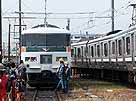
Series 185 in use for the Odoriko Limited Express service
linking Tokyo to the Izu/Hakone resort. This series 185 is in its new
livery taken after the historic Green/Orange Shonan colours.
|

1964 built Nahanefu 22 1, series 20 sleeping car, the first generation of the blue train, with train mark 'ASAKAZE' at its end.
|
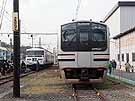
Series E217 EMU for dedicated use on the Yokosuka/Sobu Line
rapid service. This series first appeared in 1994 and had completely
driven conventional series 113 away from these lines by 1999.
|
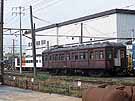
1931-built Kumoha 11 EMU used to work on the Yamanote Line in Tokyo from before World War II through the post war period.
|
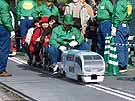
One of the day's attractions is operation of miniature trains
produced by the workshop employees. This mini-train is modeled after
the series 251 Superview Odoriko maintained here.
|
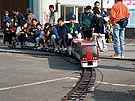
Another miniature train attracting visitors is a model of the series 253 Narita Express, which is also maintained here.
|
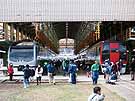
Real series 251 and 253 rolling stock exhibited in the inspection bay.
|
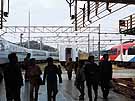
Almost all facilities are opened to the visitors. At the other
end of the inspection bay are the series 251 and Resort 21 rolling
stock.
|
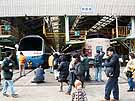
Also exhibited in the inspection bay are the Resort 21 from
Izu Express Railway on the left and the series 183 Wakashio for the
Boso limited express service on the right.
|
The following photos were taken at JR Oi workshop near Shinagawa in Tokyo on its open day held in August 1999.
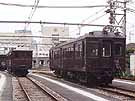
Exhibited in open space were 1929-built Kumoha 12 052 in
front, the last surviving 17 m class EMU on the Tsurumi Line until
1997, with 1914-built Nade 61 41 behind, the oldest multiple unit in
existence.
|
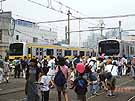
A crowd of visitors in front of 209 series commuter EMUs waiting to receive maintenance.
|
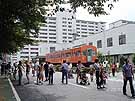
People coming in and out through the entrance gate passing by
a display of Kumoha 101-901, the first modern commuter EMU introduced
on the Chuo Line.
|
[Home Page]











